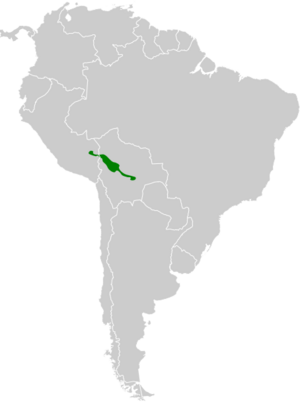Bolivian recurvebill facts for kids
The Bolivian recurvebill (Syndactyla striata) is a special kind of bird that belongs to the ovenbird family. You can find this bird living in the countries of Bolivia and Peru.
Quick facts for kids Bolivian recurvebill |
|
|---|---|
| Conservation status | |
| Scientific classification | |
| Genus: |
Syndactyla
|
| Species: |
striata
|
 |
|
Contents
About the Bolivian Recurvebill
Birds are grouped into families and types by scientists. The Bolivian recurvebill is part of the ovenbird family, called Furnariidae. It used to be in a different group of birds. But scientists studied its calls and how it behaved. They also looked at its DNA to confirm it belongs with other birds in the Syndactyla group. This bird is the only one of its exact kind within its species.
What Does the Bolivian Recurvebill Look Like?
The Bolivian recurvebill is about 19 to 20 centimeters (7.5 to 7.9 inches) long. It weighs between 37.5 and 48.5 grams (1.3 to 1.7 ounces). It's a fairly large ovenbird. It has a strong, wedge-shaped beak that points a little bit upwards.
Both male and female birds look the same.
- They have a light, creamy stripe above their eyes.
- Their face is a mix of brownish and reddish colors.
- The top of their head and back are a dark reddish-brown with lighter streaks.
- Their tail is a dull chestnut color.
- Their throat and cheeks are a reddish-orange.
- Their chest and upper belly have blurry streaks of reddish-orange and brown.
- Their lower belly is a rich brown with very few streaks.
- Their eyes are dark, and their beak is gray.
- Their legs and feet are grayish.
Where Does the Bolivian Recurvebill Live?
You can find the Bolivian recurvebill in the Andes Mountains. It lives in the foothills of southeastern Peru and in western and central Bolivia. Some experts even say it lives only in Bolivia.
This bird likes to live in humid forests. These forests are found in the foothills and lower mountain areas. They live at heights between 650 and 1,700 meters (2,130 and 5,580 feet) above sea level. While it doesn't only live near bamboo, it is often found where Guadua bamboo plants grow a lot.
How Does the Bolivian Recurvebill Behave?
Bird Movements
The Bolivian recurvebill stays in the same area all year long. It does not migrate to different places.
What the Bird Eats
The Bolivian recurvebill eats arthropods, which are small creatures like insects and spiders. It often joins groups of different bird species that feed together. It usually looks for food in the thick plants close to the forest floor. Sometimes, it will also search higher up in the trees. It finds its food by picking, pecking, and searching on dead branches, leaves, and plants that grow on other plants.
Bird Breeding
Scientists do not know much about how the Bolivian recurvebill breeds. More research is needed to understand its nesting habits and how it raises its young.
Bird Sounds
The song of the Bolivian recurvebill is described as a "harsh, rattling sound." It starts low, gets louder, then levels off, and stops suddenly. Its calls include a rough "chet" sound and a scolding, nasal "naah."
Status of the Bolivian Recurvebill
The IUCN (International Union for Conservation of Nature) checks on how safe different animal species are. At first, they thought the Bolivian recurvebill was "Vulnerable." Then, in 2008, they changed it to "Near Threatened." Since 2012, it has been listed as "Least Concern." This means it is not currently in danger of disappearing.
This change happened because more studies were done in 1992. These studies found that the bird lives in more places and is more common than people thought before. We don't know exactly how many Bolivian recurvebills there are, but their numbers might be going down.
The main threats to this bird are:
- Forests being cut down for farms.
- Areas being cleared for people to live.
- Logging (cutting down trees for wood).
- Mining operations.
Even with these threats, the Bolivian recurvebill seems to do well when its home changes a bit. Also, there are still large areas of untouched forest where it lives that are hard for people to reach. The bird also lives in several protected areas, which helps keep it safe.


